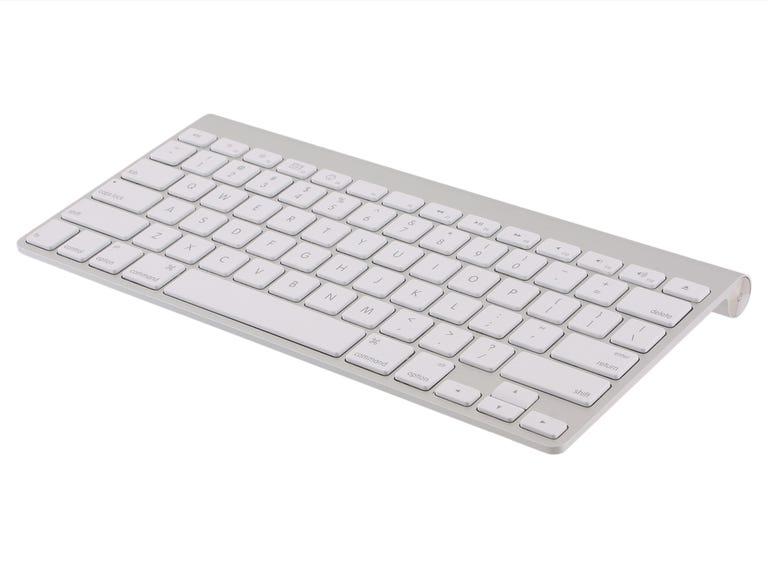 Why You Can Trust CNET
Why You Can Trust CNET Apple Wireless Keyboard (2007) review: Apple Wireless Keyboard (2007)
Apple Wireless Keyboard (2007)
Apple gives its keyboards a different aesthetic with each new generation it releases, and its latest Bluetooth Wireless Keyboard pushes the peripheral to the limits of space-saving design. This time, Apple discards the numeral keypad and gives it a much thinner profile than that of the previous full-size model. Whereas the last generation required three batteries to power it, the Wireless Keyboard only uses two batteries and improves on power conservation with a unique auto off and on feature that saves batteries over time. Apple bundles the $69 keyboard with every new iMac desktop computer, but it also is a handy iPad companion for typing longer documents on the run. For its affordability, clever design, and sheer good looks, we recommend the Apple Wireless Keyboard to anyone shopping for a Mac-friendly keyboard.
The Good
The Bad
The Bottom Line
The base of the Apple Wireless Keyboard is built from a solid cut of aluminum and bears a purposeful similarity to the MacBook Pro's unibody aluminum enclosure, with the exception of white keys instead of black. The new low-profile design not only looks clean cut, but it also reduces the amount of gunk and dust that tends to accumulate over time with standard keys. The key layout is also identical to that of the MacBook Pro's, and the top line of F-keys includes secondary shortcuts for audio, track advancement, dimming, and two one-touch launch buttons for Expose and Dashboard.
This model is also the first Apple keyboard to omit the numerical keypad, reducing the overall dimensions to 12.8-inches long by 7.3-inches wide by just 1.4-inches high. Apple's guess seems to be that most users don't typically input enough numbers on a daily basis to warrant a separate space, and we're inclined to agree. Reducing the length also means a shorter distance for your right hand to travel between the keyboard and an accompanying mouse pad, or most recently, Apple's Magic Trackpad that fits right next to the keyboard with seamless precision.
The scissor-switch style mechanisms beneath each of the keys allow for a shallow throw action (vertical travel distance) so using the Wireless Keyboard feels more like typing on a laptop, which can take some time for you to get up to speed if you're used to the standard desktop keyboard. On the other hand, if your preference leans more toward clicky, sculpted keys, Matias offers a viable alternative with the mechanical switch TactilePro 3.0 that earned our favor, but at more than twice the price.
The back of the keyboard is brushed in Apple's classic glossy white finish, with a cylindrical bar that operates as a compartment for the two included AA batteries. The round tube places your hands at a fixed angle with no mechanism for adjustment, although we felt no discomfort even after using the keyboard as our primary input device for a full day of typing. Additionally, two small rubber strips on both sides and a thicker rubber bar in the middle of the battery compartment keep the keyboard from moving around your work space.
Replacing the batteries is as simple as unscrewing a small metal plug on the left side of the tube with a coin, and Apple also makes good on its commitment to energy conversation with a convenient power management feature that automatically shuts down the keyboard after a prolonged period of inactivity and turns it back on when you start typing again.
The Wireless Keyboard connects to a computer via Bluetooth and pairing it with a Mac is incredibly easy. After you press the power button on the right side of the battery compartment, a green light starts flashing to indicate that the keyboard is ready to connect. The keyboard will display under "devices" as soon as you launch the Bluetooth Setup Assistant, and after a few key press tests, you're ready to begin typing. In our anecdotal tests, we successfully paired the Wireless Keyboard to an iMac, a Mac Mini, a MacBook Pro, and an iPad, in less than 2 minutes for each device with zero hiccups. It can also pair with Windows Vista and Windows 7 PCs, but note that the function and command keys won't line up with the standard Windows keyboard layout.
We were also impressed to learn that of the keyboard's compatibility with Apple's latest iOS software for the iPhone 4 and third-generation iPod Touch. When you pair it with those mobile devices, the function keys on the top row can even alter settings like brightness, volume, and track control. Finally, the "eject" button on the far right brings up the onscreen virtual keyboard within mobile apps like Notes and Contacts.


